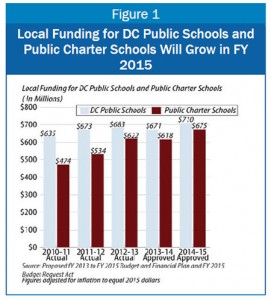The city may be in the midst of its summer slowdown, but DCFPI wants to make sure you are up to date on what to expect in the DC budget for next year. Today, we’ll give you a summary of what’s in store for two of the biggest parts of the DC budget, health and education, from DCFPI’s budget toolkit. We’ll cover more issue areas, and provide an analysis of the entire budget, before long.
Health Care in DC’s FY 2015 Budget
The District plans to spend $3.5 billion in local and federal funding on health care funding next year. That is a 6 percent increase after adjusting for inflation. The budget includes:
- Continued Growth in Medicaid Program. The Department of Health Care Finance — which administers Medicaid — represents 85 percent of the growth in healthcare expenditures. This reflects higher per-person costs in the Medicaid managed care program and a 3 percent growth in enrollment.
- Greater Local Investment in Public Health Programs for Children. The FY 2015 budget invests new local funds in Home Visiting — which supports health and cognitive development for children under age five — to replace expiring federal funds. The budget also expands school-based mental health to six additional schools. Still, fewer than half of all schools (DCPS and charter) will have a mental health professional.
- A New Funding Mechanism to Sustain the DC Health Exchange. Federal funds have been covering the costs to operate the District’s exchange, DC Health Link, but next year the city will have to pay those costs. So the DC Council established a dedicated, local tax to fund the exchange’s $29 million budget.
Education in DC’s FY 2015 Budget
The city will spend $1.9 billion in local funds on education next fiscal year, a 6 percent increase after adjusting for inflation. That includes:
- Changes to the School Funding Formula. The budget increases base per-pupil funding by 2 percent for both DC Public Schools and Public Charter Schools. It also increases amounts provided for students in adult and alternative education, English language learners, and special education students.
- New At-Risk Funding. The budget adds $81 million for 36,000 at-risk students across both sectors. Summer school will also be funded by this amount. DCPS plans to use new funds to add staff and supports for middle grades, and to extend the school day at up to 52 schools, among other initiatives. But teachers have approved a longer school day at only a handful of schools, and it is not clear at this time what will happen at the others.
- Investments in Early Childhood Education. The budget adds $4 million to build DC’s system for rating and improving the quality of early childhood programs. Another $5.2 million is included to support additional child care slots for infants and toddlers.
Keep checking back with the District’s Dime for more toolkit updates this summer!
To print a copy of today’s blog, click here.
